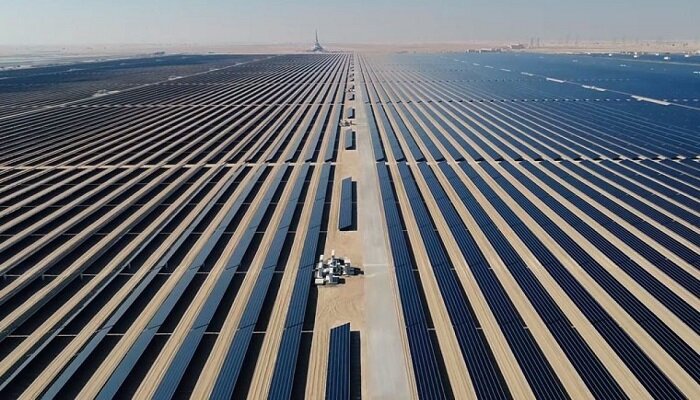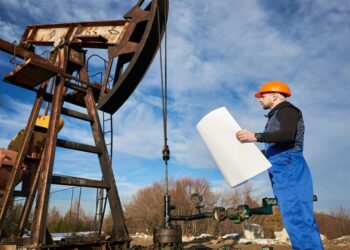It doesn’t come as a surprise that the desert landscape is adorned with vast expanses of solar panels that happen to be meticulously arranged in symmetrical patterns. This is indeed a mesmerizing sight that goes on to form a shimmering field that extends as far as the eye has vision. In the centre of many panels stands a high vertical structure, radiating a brilliant glow even in bright daylight. The structure happens to be surrounded by a system of strategically positioned smart mirrors, which go on to track the movement of the sun and also reflect concentrated sunlight onto the top of the tower.
The Mohammed bin Rashid Al Maktoum Solar Park happens to be an impressive marvel situated in Saih Al-Dahal, which is around 50km south of Dubai. It holds the reputation of being the world’s largest renewable project, which is based on the independent power producer- IPP model. The largest single-site solar park across the world happens to be owned by the Dubai Electricity and Water Authority- DEWA and goes on to cover a vast area of 77 km2. The park happens to have an ambitious goal of generating 5,000 MW of energy from renewable sources by the decade-end. To achieve this, an overall investment of AED 50 billion has been allocated. Once that is completed, the park is anticipated to significantly reduce carbon emissions by more than 6.5 million tonnes per year.
In 2021, the UAE went on to initiate an ambitious program with the idea of achieving net-zero emissions by 2050. This initiative has a significant investment of 600 billion dirhams, which is around $163 billion in renewable energy. By doing so, the UAE became the major country in the Middle East as well as in the North Africa region to successfully launch such a prominent initiative. As per Mohammad Ahmad Jame, who happens to be the Acting VP of Clean Energy and Diversification at DEWA, the projects within the solar park happen to be necessary in supporting the strategy that is put in place to achieve a sustainable economy.
The solar park has been established across numerous phases, with each phase adding different capabilities. The park makes use of a mix of solar photovoltaic- PV and concentrated solar power- CSP technologies when it comes to electricity generation. The solar park, as of date, has multiple projects that are under construction, all making use of CSP technology. The overall capacity of these projects happens to be 433 MW.
The first phase, which happens to have a capacity of 13 MW, makes use of PV panels and got successfully launched in October 2013. The sixth phase is anticipated to have a capacity of 1,800 MW and may lessen the annual carbon emissions by 2.36 million tonnes. DEWA carried out solar tracking systems, smart grid technologies, as well as energy storage solutions in the advanced phases so as to elevate efficiency and at the same time lessen the environmental impact.
During one of the visits to the solar park in Dubai, the spokespersons from DEWA shared that DEWA not just goes on to offer strategic partnerships with global companies, but it also focuses on integrating renewable energy as well as distributed generation into the electricity grid. Moreover, DEWA is involved in numerous areas like IoT, utilizing AI in energy production units, elevating energy efficiency, making sure of cybersecurity, advancing robotics, as well as promoting smart buildings. One example happens to be Unilever, which is a global leader when it comes to consumer goods and has been making use of DEWA’s electricity and working together with it so as to promote sustainability and also decrease Dubai’s carbon footprint by way of a range of initiatives. Apparently, in 2013, DEWA and Unilever signed a MoU wherein Unilever committed to executing energy-saving devices and also promoting water conservation. In 2019, DEWA yet again entered into an agreement with Unilever to sell 20,757 International Renewable Energy Certificates- i-REC to the company. i-RECs happen to be certified credits that can be bought as well as sold in renewable energy markets by way of various parties. The internationally acknowledged standard for documenting renewable energy usage is widely taken into account. Unilever Middle East has gone on to achieve the ability to power its overall electricity consumption in the region along with renewable energy by way of buying i-RECs from DEWA. Unilever has set an objective to become carbon-neutral across all of its operations by the end of this decade. To make sure that this objective is attained, the company has formed a prominent partnership with DEWA.
It is indeed worthy to note that certain companies have taken the initiative to come up with their own solar power plants so as to support the COP28 host’s goal of getting to net zero emissions by 2050. In 2022, Daikin Middle East and Africa, one of the prominent manufacturers of air conditioning, heating, ventilation, as well as refrigeration solutions, showed their commitment to environmental ownership by commissioning a 515 kWp solar plant at the JAFZA Dubai headquarters. It is well to be noted that Daikin happens to be a signatory to the ‘Climate-Responsible Companies Pledge’ and looks forward to achieving net zero emissions by 2050. The company has installed almost 1,000 solar panels on the roof of their facility, which now meet over 80% of its energy consumption needs.
Sanjeev Maheshwari, who is the General Manager- Service, Solution, and Refrigeration at Daikin Middle East and Africa, opines that Daikin has made major advancements when it comes to the HVAC-R field and is also introducing innovative technologies that are aimed at lessening emissions from their products. The company states that its R32 technology happens to be revolutionary in its capacity to significantly reduce greenhouse gas emissions. The R-32 refrigerant is indeed a widely recognized and well-balanced refrigerant that comes with numerous environmental advantages. These include lessened electricity usage and a lower global warming potential as compared to other commonly used refrigerants such as R-22 and R-410A, with a reduction of one-third. By making use of its extensive knowledge and experience as the sole manufacturer that creates and produces both air conditioners as well as refrigerants, Daikin has executed the use of R-32 in their air conditioning units quite effectively.
The Sustainable City in Dubai happens to be a remarkable green initiative presented to the world by Diamond Developers, which is a private sector real estate company that leads the sustainable building movement.
As per Marwa Nahlawi, the General Manager of Diamond Developers, TSC has been designed as a functional net-zero energy city with the objective of becoming a global example in terms of sustainable living. The community happens to be located on the outskirts of Dubai and goes on to cover an expanse of 46 hectares, which comprises a total of 500 villas, which happened to be organized into five residential clusters that are connected to an urban farm that stretched through the entire length of the city. Each cluster happens to be a cluster of 90 Courtyard Villas, 8 Garden Villas, and 2 Signature Villas, which happen to be currently occupied by almost 2,700 residents. The city is equipped with numerous amenities, which include a school, an equestrian centre, as well as a center called Sanad Village. The facilities are designed so as to offer a holistic along with a comprehensive approach so as to addressing autism spectrum disorders. The city’s mosque has the capacity to accommodate 700 worshippers and comes equipped with advanced technology that reduces energy and water consumption.
There happen to be 11 biodome greenhouses located along the Central Green Spine, which provide a combined urban farming capacity of over 3,000 square meters. The city has also implemented a 10-meter-high buffer zone in the development, featuring trees arranged in varied layers. The purpose of this is to make the air that enters the city clean. It is well to be noted that the city happens to have a total of 10,000 trees, which are both productive and non-productive.
But the renewable energy system, in every likelihood, is the most distinctive feature when it comes to Sustainable City Dubai. The community’s power supply happens to be primarily sourced from a 10-megawatt solar farm, which goes on to feature an impressive cluster of more than 40,000 solar panels. The robust solar infrastructure happens to serve as the main sustainability source for the entire community by way of providing power to residences and also to public amenities such as schools, malls, and hospitals. It is important to take note that any excess energy that happens to be produced by the solar farm is sent back to the grid, thereby further establishing Sustainable City Dubai as a net energy exporter.
Apart from its impressive energy capabilities, the community also has an innovative water management system. By making use of strategically implementing advanced technologies like greywater recycling, rainwater harvesting, and wastewater treatment, the community effectively decreases water consumption. A wastewater treatment plant that is specifically designated for this arrangement goes on to process sewage from residents and then converts it into high-quality recycled water that gets used for irrigation and landscaping.
It is well to be noted that the primary task of the COP is to assess the progress that’s been made towards achieving the goal of the Paris Agreement, which is to limit global temperature rise to less than 2 degrees Celsius. Dubai showcases initiatives such as The Sustainable City, which has taken a 2-degree pledge so as to limit the temperature rise, thereby highlighting Dubai’s dedication when it comes to preserving the planet.



















































